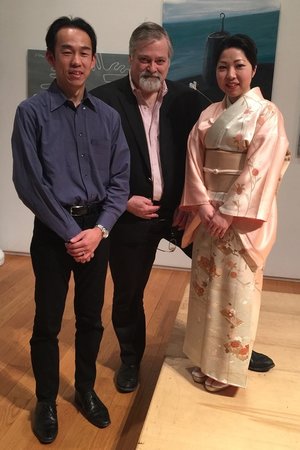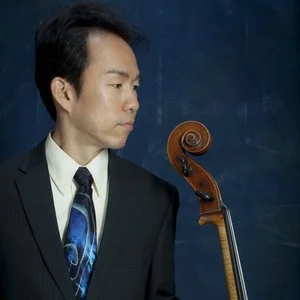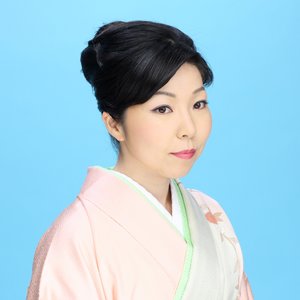Lady Tomoe is pictured in the 1899 woodblock print with Uchida leyoshi and Hatakeyama no Shigtada by Yōshū Chikanobu.
About the Heike Quarto Project
The Tale of Heike, an epic medieval chronicle, was compiled from oral stories chanted by traveling monks who sang to the accompaniment of the biwa, an instrument somewhat like the lute. Duo YUMENO (Yoko Reikano Kimura, koto; and Hikaru Tamaki, violoncello) has commissioned American composer Daron Hagen to create four large-scale works for koto and cello based on characters and stories from the great Japanese epic. The resulting collection is titled The Songs of Heike. Part One is called Appassionato; Part Two is called Cantabile; and part three is called Misterioso. The final movement, Grandioso, receives its world premeire in Kyoto, Japan, on 17 June 2018.
Duo YUMENO and composer Hagen at the Tenri Cultural Institute in Manhattan.
It is important to note that, with each duo, the performers are requested to display greater flexibility and range of expressionas performers: progressive demands are made upon them to sing in English, Japanese, and French, to chant, to whistle, and to perform percussive sound-effects on their instruments.
- Learn more about Duo YUMENO
- Learn more about Appassionato
- Learn more about Daron Hagen
PART ONE: APPASSIONATO (2015)
In the first duo, the koto player chants “Hei,” an alternate reading of the first character of Taira, the name of the family that figures centrally in the story. The core theme of the chronicle is the Buddhist law of impermanence. In The Tale of Heike, arrogance and pride of power lead to the Taira family’s destruction. Helen Craig McCullough’s translation begins with this statement: “The proud do not endure, they are like a dream on a spring evening; the mighty fall at last. They are as dust before the wind.” The title Appasionato, suggested by Duo YUMENO, inspired a juxtoposition throughout of overtly emotional, dramatic musical gestures and contemplative, static, otherworldly gestures. Rather than attempting to craft an extra-musical narrative for the duo, Hagen chose a single situation near the end of the story that manifested most vividly the work’s theme. He created three movements (Before, During, After) that addressed empress Kenreimon’s moment of truth: in the first movement, she remembers the glories of the Taira family. In the second, she describes a dream in which she saw Taira asking her to pray for the family’s salvation. In the final movement, she struggles to separate from this world, invoking Amida’s name, and is at last welcomed by Amida Buddha to the Pure Land. Learn more about this work by clicking here.
PART TWO: CANTABILE (2016)
For the second duo Hagen chose another key character in the story, crafting three movements (Without, Cavatina, Within) that address the historical (and literary) figure Taira no Tokuko's three states of existence. Without is a portrait of her as, in turn, daughter, consort, and mother of an emperor. Cavatina is a portrait of her years as a recluse and Buddhist nun. The final movement, Within, is a setting of the following poem, said to have been written by the great lady in her twilight:
“Ai-je jamais rêvé
Que je contemple la Lune
Ici, sur la montagne -
La lune que j’ai l’habitude de voir
Dans le ciel dessus le palais?
Did I ever dream
That I would behold the moon
Here on the mountain —
The moon that I used to view
In the sky o’er the palace? ”
Cellist Hiraku Tamaki.
PART THREE: MISTERIOSO (2017)
The third duo tells the story of Kogō (portrayed by the koto), Takafusa, and the Emperor's man, Takakuna (both men are portrayed by the cello). Kogō was the most beautiful lady and the finest koto player in the palace. Takafusa’s love for her was deep and pure. When she was summoned to Emperor Takakura’s side upon the death of his beloved consort Aoi No Mae, she fulfilled her duty. Sadly, Takafusa was one of mankind’s saddest souls, for, as Gide observed: “Nothing thwarts happiness as much as the memory of happiness.” He could not let her go. The work is in three movements: 1. Kogō and Takafusa, 2. Kogō Alone, 3. Kogō and Nakakuni.
Movement 1 (Kogō and Takafusa) portrays the lovers in the moonlight, illuminated by their grief. Kogō sings the words of a poem Takafusa has dared to send her, which begins:
When I think of you / There is no end to my pain
Upon her honor, she cannot finish reading the poem. She discards it and pours her feelings out in the still night playing her koto, counterpointed by the sounds of the whistling night wind, the lonesome calls of the gulls, and Takafusa's cries. Movement 2 (Kogō Alone) portrays Kogō, who has fled the palace, living in hiding in a humble cottage near the village of Saga. The Emperor’s faithful man Nakakuni is searching for her, this poem on his mind:
Here in the mountains / Near the village of Saga, / The fawns are crying. / A man is full of sorrow / In autumn, when night has come.
In Movement 3 (Kogō and Nakakuni), the story of Nakakuni discovering Kogō at the Hōrin Temple is told. He hears her playing the melody (I quote a fragment of it) of Sōfuren, which tells of a wife longing for her husband. Nakakuni draws his flute from his sash and plays with her. We hear his flute, her cries of anguish, her koto, his fists banging repeatedly on the door. She tells him that she cannot return with him to the palace. Arrested, she is forced, at age 23, to become a nun, her beauty imprisoned by a black robe, living in the wilderness of Saga. The words sung during the movement are those Nakauni had in mind when he set out to find Kogō. She remembers the words of Tokuko (“Ici, sur la montagne - / La lune que j’ai l’habitude de voir / Dans le ciel dessus le palais?”) as she thinks of their shared destinies as nuns. At the end, she is alone, praying.
Koto player Yoko Reikano Kimura.
PART FOUR: GRANDIOSO (2018)
The fourth and final panel of the quarto takes inspiration from visual images of Tomoe Gozen, a late twelfth-century female samurai warrior known for her nobility, bravery, and great beauty–particularly the 1899 woodblock print of her (shown above) with Uchida leyoshi and Hatakeyama no Shigtada by Yōshū Chikanobu. In movement one Lady Tomoe, she prepares herself spiritually for the Battle of Awazu on 21 February, 1184. In movement two, Horse Whispering, she tames an "unbroken horse" through tenderness and strength. In movement three, the apotheotic Grandioso, Tomoe, in old age, having become a nun, recalls how Yoshinaka, (as related in the Tale of Heike) sent her out as his "first captain," clad in armor and bearing an oversized sword and bow. Although she fought bravely and honorably, the battle was lost and she was forced to flee. Years of spiritual searching and service have led her to the quiet grandeur known only to the most spiritually evolved. The composition ends with Tomoe in the final moments of her life, contemplating eternity.
About Duo YUMENO
New York based koto / shamisen player and singer Yoko Reikano Kimura and cellist Hikaru Tamaki create a singular fusion sound, inspired by tradition but with a contemporary sensibility. Duo YUMENO’s repertoire includes a dynamic range of compositions – both traditional and contemporary - all of which explore the dialogue between classical Japanese and western music. Duo YUMENO champions works by contemporary American and Japanese composers, including Marty Regan, Daron Hagen, James Nyoraku Schlefer, Gene Coleman, Yoko Sato, Martin Max Shreiner, Lou Harrison, Minoru Miki, Takatomi Nobunaga and Hiroki Tamaki. In 2014, they were awarded the Chamber Music America Classical Commissioning Program grant to commission a new work by Gene Coleman, and in 2015, received the Aoyama Baroque Saal Award. Their activities have been featured in the media, like the New York Times, Chamber Music Magazine, New York Classical Review, Yomiuri Shimbun, Hōgaku Journal and NPR.
Yoko Reikano Kimura and Hikaru Tamaki first collaborated at the Fort Wayne Cherry Blossom Festival in 2008 and since then, have been performing together regularly in Japan and the US. Between 2010 and 2013, they have presented the Kacho-fugetsu concert series, for which they commissioned works by Marty Regan over a four year period. In recognition of the Kacho-fugetsu series, they were awarded the Janet Latz Professional Fellowship in 2011. Since 2010, they have held a successful annual tour to Japan that has extended to such cities as Tokyo, Kyoto and Osaka. Some of the notable venues are the Tokyo National Museum, the Myōnichi-kan Auditorium (Tokyo), the Aoyama Music Memorial Hall (Kyoto), Ryōan-ji and Yakushi-ji Temples. They have been actively presenting their cross-cultural programs throughout the US and have performed at venues such as the United Nations, New England Conservatory, Princeton University, Tufts University, Texas A&M University, Ball State University, Bargemusic, Bryant Park, Tenri Cultural Institute of New York, Globus Washitsu, Renaissance Society of Chicago and Krasl Art Center (MI).
The duo was invited to Turkey in 2013, performing at the former Consulate General of Japan in Istanbul and at Namik Kemal University in Tekirdag. In 2014, they visited Trinidad and were featured at the opening concert of "Japan - CARICOM (14 Caribbean countries) Friendship Year 2014" – an event promoted by the Japan Foundation, NY and co-organized by the Embassy of Japan in Trinidad and Tobago. In 2015, the duo was invited to perform at Clare Hall, a constituent college of the University of Cambridge, to present a concert featuring classical and modern works for Japanese instruments.





